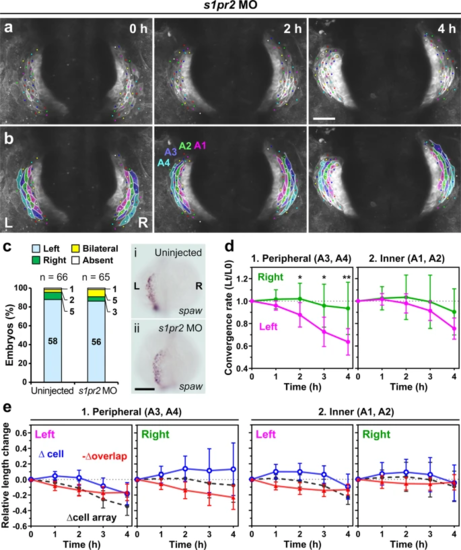Fig. 6
- ID
- ZDB-FIG-220923-37
- Publication
- Kidokoro et al., 2022 - Nodal signaling regulates asymmetric cellular behaviors, driving clockwise rotation of the heart tube in zebrafish
- Other Figures
- All Figure Page
- Back to All Figure Page
|
a, b Embryos with cardia bifida were created by injecting s1pr2 MO, which inhibits endoderm convergence and subsequent heart primordia fusion. Asymmetric convergence still occurred in the two hearts. a Selected images from a confocal time-lapse recording of a s1pr2 MO-injected Tg(myl7:EGFP-CAAX)ncv536Tg embryo starting at 19–20 hpf (Supplementary Movie 6). Dorsal view (anterior to the top). Scale bar = 50 µm. b Colored, corresponding images to those in a. Four cell arrays are labeled with different colors (A1–A4). c spaw mRNA expression in uninjected (i) and s1pr2 MO-injected (ii) embryos was assessed by in situ hybridization. The bar graph shows percentage of control (uninjected siblings, n = 66) and s1pr2 MO-injected embryos (n = 65) with left-sided, right-sided, bilateral, or absence of spaw expression in the lateral plate mesoderm (LPM). Morpholino injection did not perturb the normal left-sided spaw expression in the LPM. Scale bar = 200 µm. d Plots of the relative lengths (Lt/L0) of peripheral (1) and inner (2) cell arrays in s1pr2 MO-injected embryos (cardia bifida). The left cell arrays in the peripheral region (A3 and A4) converged more rapidly than the right ones, whereas no significant difference was observed between the left and right cell arrays in the inner region (A1 and A2), similar to that as in normal embryos shown in Fig. 5. *p < 0.05, **p < 0.01, ***p < 0.005 (two-tailed t-test assuming unequal variances, n = 4 embryos). Means ± s.d. are shown. e Relative length changes of cell arrays (black), cells (blue), and loss of the cell lengths caused by the cell overlap (red) in the peripheral (1) and inner (2) cell arrays in s1pr2 MO-injected embryos. n = 4 embryos. Means ± s.d. are shown. For d, e, corresponding graphs indicating individual data points are shown in Supplementary Fig. 5. |

